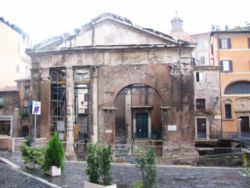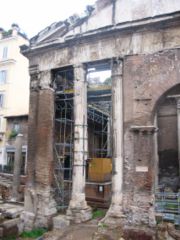
Porticus Octaviae
Encyclopedia

- Not to be confused with the Porticus OctaviaPorticus OctaviaThe Porticus Octavia was a portico in ancient Rome, built by Gnaeus Octavius in 168 BC to commemorate a naval victory over Perseus of Macedonia. It stood between the theatre of Pompey and the circus Flaminius...
.
The Porticus Octaviae (portico
Portico
A portico is a porch leading to the entrance of a building, or extended as a colonnade, with a roof structure over a walkway, supported by columns or enclosed by walls...
of Octavia; ) is an ancient structure in Rome
Rome
Rome is the capital of Italy and the country's largest and most populated city and comune, with over 2.7 million residents in . The city is located in the central-western portion of the Italian Peninsula, on the Tiber River within the Lazio region of Italy.Rome's history spans two and a half...
.
Built by Augustus
Augustus
Augustus ;23 September 63 BC – 19 August AD 14) is considered the first emperor of the Roman Empire, which he ruled alone from 27 BC until his death in 14 AD.The dates of his rule are contemporary dates; Augustus lived under two calendars, the Roman Republican until 45 BC, and the Julian...
in the name of his sister, Octavia Minor
Octavia Minor
Octavia the Younger , also known as Octavia Minor or simply Octavia, was the sister of the first Roman Emperor, Augustus , half-sister of Octavia the Elder, and fourth wife of Mark Antony...
, at some time after 27 BC
27 BC
Year 27 BC was either a common year starting on Sunday, Monday or Tuesday or a leap year starting on Monday of the Julian calendar and a common year starting on Sunday of the Proleptic Julian calendar...
, in place of the Porticus Metelli, the porticus enclosed within its colonnaded walks the temples of Jupiter Stator
Temple of Jupiter Stator (2nd century BC)
The Temple of Jupiter Stator was a temple of Ancient Rome named after the god Jupiter in his form of Jupiter Stator . Together with the temple of Juno Regina and the enclosing Porticus Metelli , it was built by Q. Caecilius Metellus Macedonicus after his triumph in 146 BC...
and Juno Regina, next to the Theater of Marcellus. It was burned in 80
80
Year 80 was a leap year starting on Saturday of the Julian calendar. At the time, it was known as the Year of the Consulship of Augustus and Domitianus...
and restored, probably by Domitian
Domitian
Domitian was Roman Emperor from 81 to 96. Domitian was the third and last emperor of the Flavian dynasty.Domitian's youth and early career were largely spent in the shadow of his brother Titus, who gained military renown during the First Jewish-Roman War...
, and again after a second fire in 203
203
Year 203 was a common year starting on Saturday of the Julian calendar. At the time, it was known as the Year of the Consulship of Plautianus and Geta...
by Septimius Severus
Septimius Severus
Septimius Severus , also known as Severus, was Roman Emperor from 193 to 211. Severus was born in Leptis Magna in the province of Africa. As a young man he advanced through the customary succession of offices under the reigns of Marcus Aurelius and Commodus. Severus seized power after the death of...
and Caracalla
Caracalla
Caracalla , was Roman emperor from 198 to 217. The eldest son of Septimius Severus, he ruled jointly with his younger brother Geta until he murdered the latter in 211...
. It was adorned with foreign marble, and contained many famous works of art, enumerated in Pliny's Natural History.

Marcus Claudius Marcellus (Julio-Claudian dynasty)
Marcus Claudius Marcellus was the eldest son of Octavia Minor, sister of Augustus, and Gaius Claudius Marcellus Minor, a former consul...
, the curia
Curia
A curia in early Roman times was a subdivision of the people, i.e. more or less a tribe, and with a metonymy it came to mean also the meeting place where the tribe discussed its affairs...
Octaviae, and a schola. Whether these were different parts of one building, or entirely different structures, is uncertain. It was probably in the curia that the senate is recorded as meeting. The whole is referred to by Pliny the Elder
Pliny the Elder
Gaius Plinius Secundus , better known as Pliny the Elder, was a Roman author, naturalist, and natural philosopher, as well as naval and army commander of the early Roman Empire, and personal friend of the emperor Vespasian...
as Octaviae opera.
In the medieval era, it was used as a fish market
Fish market
A fish market is a marketplace used for marketing fish products. It can be dedicated to wholesale trade between fishermen and fish merchants, or to the sale of seafood to individual consumers, or to both...
, which lasted up to the end of 19th century. This role is remembered by the name of the annexed church of Sant'Angelo in Pescheria
Sant'Angelo in Pescheria
Sant'Angelo in Pescheria or in Piscaria is a church in Rome. It dates from the 8th century. "In Pescheria" refers to its location close to the fish market built in the ruins of the ancient Porticus Octaviae....
(Italian: "St. Angelus in the Fish Market").
The portico, which lies in rione
Rioni of Rome
A rione is an Italian term used since the Middle Ages to name the districts of Rome, according to the administrative divisions of that time. The word originates from the Latin word regio A rione (pl. rioni) is an Italian term used since the Middle Ages to name the districts of Rome, according to...
Sant'Angelo
Sant'Angelo (rione of Rome)
Sant'Angelo is the eleventh historic district or rione of Rome, often written as rione XI - Sant'Angelo. Its coat of arms is an angel on a red background, holding a palm branch in its left hand. In another version, the angel holds a sword in its right hand and a scale in its left.Sant'Angelo, the...
, represents the center of the Roman Ghetto
Roman Ghetto
The Roman Ghetto was a ghetto located in the rione Sant'Angelo, in Rome, Italy, in the area surrounded by today's Via del Portico d'Ottavia, Lungotevere dei Cenci, Via del Progresso and Via di Santa Maria del Pianto close to the Tiber and the Theater of Marcellus...
.
External links
- LacusCurtius.com: Samuel Ball Platner, revised by Thomas Ashby, A Topographical Dictionary of Ancient Rome: Porticus Octaviae
- The Portico of Octavia (etchingEtchingEtching is the process of using strong acid or mordant to cut into the unprotected parts of a metal surface to create a design in intaglio in the metal...
by Giovanni Battista PiranesiGiovanni Battista PiranesiGiovanni Battista Piranesi was an Italian artist famous for his etchings of Rome and of fictitious and atmospheric "prisons" .-His Life:...
) at the Metropolitan Museum of ArtMetropolitan Museum of ArtThe Metropolitan Museum of Art is a renowned art museum in New York City. Its permanent collection contains more than two million works, divided into nineteen curatorial departments. The main building, located on the eastern edge of Central Park along Manhattan's Museum Mile, is one of the...
(New York CityNew York CityNew York is the most populous city in the United States and the center of the New York Metropolitan Area, one of the most populous metropolitan areas in the world. New York exerts a significant impact upon global commerce, finance, media, art, fashion, research, technology, education, and...
)

